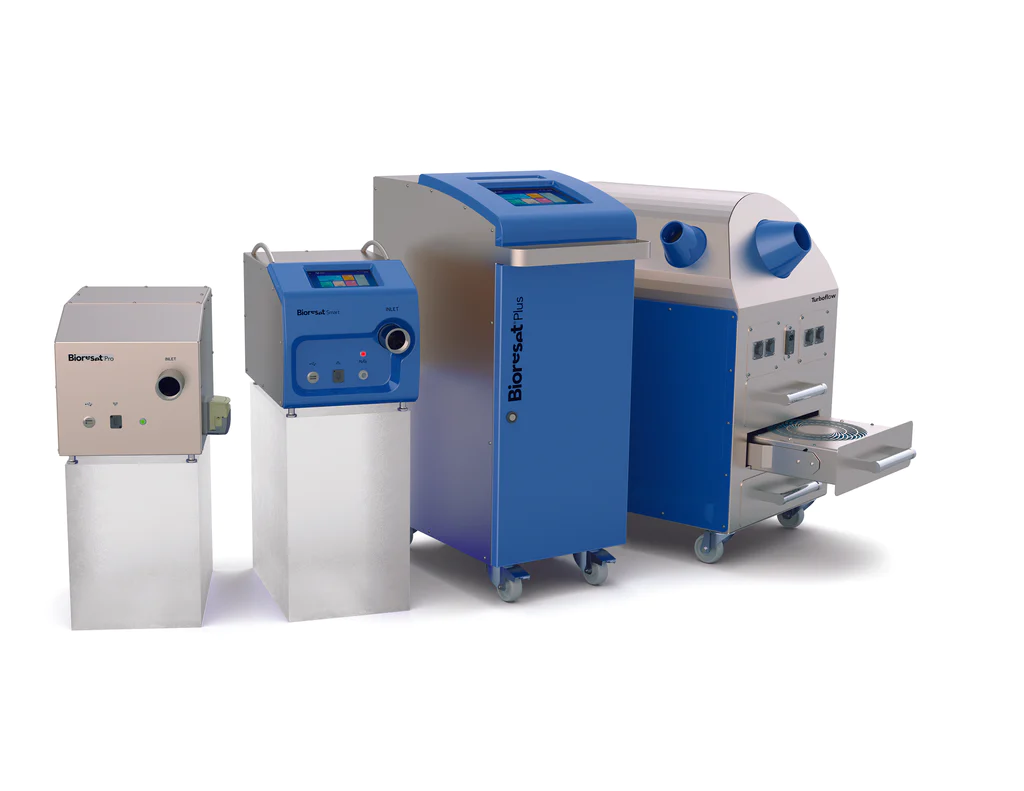Cleanrooms are one-of-a-kind production areas that are free of contamination.
Cleanrooms are designated areas where the presence of germs and inert particles is guaranteed to be less than a certain quantity per unit of volume.
Bacteria, fungi, and protozoa are microorganisms that live in the air and on surfaces, and they, like some viruses, can survive in space.
Bioaerosols are airborne contaminants that bond to dust, liquid particles, and other naturally existing contaminants.
Cleanrooms are intended to minimize the introduction, creation, and retention of airborne particles inside the ambient environment, allowing activities that are sensitive to contamination.
Smooth, waterproof, and uninterrupted surfaces, steel furnishings, beveled edges, and low particle release materials must all be used to minimize the entry of particulate sources.
To avoid the entrance of potentially contaminating inverse flows, cleanrooms are designed using "dynamic containment" technology.
The atmosphere of the rooms is kept under constant overpressure and managed with an increasing gradient towards the areas with the maximum cleanliness.
Pressure gauges are used to measure differential pressures continuously.
Environmental contaminants must be entirely removed from clean rooms, including any form of biological contaminant, whether in the air or on surfaces.
Cleanroom decontamination is necessary if the sterility has been compromised.
Using a dependable and verified room bio-decontamination service lowers the danger of your product or the environment becoming contaminated.
When is it necessary to Decontaminate Cleanrooms?
Biological contamination will occur in all types of cleanroom facilities to some level.
Controlling microbiological contamination is critical in any setting, whether it's a tiny quality control lab or a huge vaccine manufacturing facility.
If the cleanliness of the cleanroom is compromised, it must be decontaminated as soon as possible.
The personnel who work in the cleanroom are more than likely to introduce biological contamination.
Direct contact with surfaces, respiratory aerosols, and the shedding of hair and skin particles are all examples.
Biological contamination can also develop due to leaks in service pipes, faulty air filters, poorly maintained ventilation systems, or containment loss due to power or plant failures.
Persistently high viable numbers may be the first sign of a problem during routine monitoring.
Before beginning a room bio-decontamination service, the cause of the contamination should be identified so that targeted remedial work or a change in process may ensure the situation does not recur.
Biodecontamination will be required if a facility has been shut down for routine maintenance, alteration, or renovation.
The following considerations must be taken into account while deciding on the best decontamination method:
Efficacy:
It is critical to have consistent and reliable performance against various organisms, particularly those that are difficult to deactivate (such as tuberculosis and anthrax).
Fully Documented:
To maintain compliance, detailed, professionally produced reports are required to ensure method traceability and process validation.
Speed:
Quick decontamination cycles cut down on plant downtime and lower operating expenses.
Materials Compatibility:
Some decontamination procedures cause long-term damage to plastics and painted surfaces.
More traditional (and labor-intensive) techniques of Biodecontamination, such as spraying and wiping an appropriate disinfectant onto a surface, can be used.
The requirement to remove residuals and the difficulty in assuring coverage over a large region are disadvantages of the manual approach (particularly in rooms).
There are also issues with the technique's evaluation, which needs a large-scale field trial.
There are various methods to keep your cleanrooms under control from the microbial load, as mentioned below.
The chart indicates why Hydrogen Peroxide is eco-friendly and safe for all living beings.
1. Formaldehyde
2. Ozone
3. Ethylene Dioxide
4. Nitrogen Dioxide
5. Chlorine Dioxide
6. Hydrogen Peroxide (Dry Fogging)
7. Vaporized Hydrogen Peroxide (Gas)
There are two different methods of Hydrogen Peroxide that can be utilized for Bio-decontamination; however, the use of each of them has pros and cons over one; before that, let us try and understand both processes:
Hydrogen Peroxide Mist/ Aerosol/ Spray/Dry Fog:
One may find this process under different names; however method remains the same.
The use of liquid H2O2 With 50 ppm silver ions, 50 ppm phosphoric acid, and 1 ppm Arabica gum as catalysts, a commercial system creates a fine mist (particle sizes between 8 and 10 microns) of 5 percent hydrogen peroxide in air.
The aerosols disintegrate with time, the hydrogen peroxide reacts, and the situation decreases to a safe level. There isn't a lot of published proof. This method is most economical however has a lot of limitations of its own.
Non-condensing Vapor:
The hydrogen peroxide (usually at a concentration of 35 percent) is vaporized using a specially designed vapor generator under carefully controlled temperature, humidity, and pressure conditions, ensuring no condensation occurs in the subjected area.
This state is maintained in the enclosure for a long time, during which ultra-deadly hydrogen peroxide concentrations in the air are maintained for disinfection.
This is the most crucial stage in terms of microbial kill.
Finally, the enclosure is purged with air (catalytic aeration) until the hydrogen peroxide concentration is below the product exposure limit (as a safety indicator).
Let us compare both these processes.
VaporAerosol, Spray, Dry Fog
n physics, a vapor is a substance in the gas phase at a temperature lower than its critical point, which means
that the vapor can be condensed to a liquid by increasing the pressure on it without reducing the temperature.
An aerosol is a suspension of tiny particles of liquid, solid, or both within a gas.Easy to distributeNot easy to distributeNo residues Residues after evaporationHigh material compatibility (gas)Possible compatibility risk for material (liquid)
The residues left behind by the use of Mist/ Aerosol/ Spray/Dry Fog methods need extensive cleaning post the process and the same may or may not be compatible with the surface of treatment.
H2O2 in the liquid phase acts 3-4 times more corrosive in nature and hence has a lot of limitations over the use.
Also, the distribution of mist is more difficult in every corner of the subjected area and may require multiple equipment to the place which may not be feasible for rooms with higher ceiling heights & difficult to reach areas or highly equipped areas like process vessels or fermentors, V-PHP (Vapor phase H2O2) outperforms the traditional methods of decontamination by excelling in distribution & leaving NO-RESIDUE behind.
The Vapor Phase of Hydrogen Peroxide (V-PHP)
Hydrogen peroxide has a signature pungent odor and is transparent, colorless, and 'water-like' in appearance.
Compared to formaldehyde, hydrogen peroxide vapor has rapid antibacterial activity, high material compatibility, and fewer safety issues.
Hydrogen peroxide has microbicidal efficacy against a wide range of organisms, and this broad spectrum of action results from the chemical's oxidizing capacity.
Proteins, lipids, and nucleic acids in cells are damaged by the chemical. In terms of efficacy, hydrogen peroxide in gaseous form outperforms hydrogen peroxide in liquid form.
Hydrogen peroxide is compatible with a wide range of materials, including plastics, metals, paint, and electrical equipment.
Although there are operational dangers from the vapor, they are reduced at the end of the process compared to formaldehyde since hydrogen peroxide is thermodynamically unstable and decomposes into water and oxygen.
When employing hydrogen peroxide, the vapor can irritate the eyes, mucous membranes, and skin, and it can even cause lung irritation if inhaled.
Furthermore, if skin contact with liquid hydrogen peroxide is not immediately rinsed away, it can cause transient bleaching, redness, and blisters.
V-PHP is a rather quick cleaning method when used with barrier systems and rooms. Because the procedure, as previously said, is one of decontamination, important surfaces must be sterilized individually (as would be the case with aseptic processing.
Vaporized Hydrogen Peroxide Bio-decontamination Process:
Bio-decontamination with hydrogen peroxide necessitates a sequence of processes.
A specially designed generator is used to produce vapor in this method.
Generators work similarly, establishing a closed loop with the fumigated area. This is how it works:
Waiting Phase
The air is pumped through the generator and the liquid H2O2 (@35% Conc) is vaporized using a specially designed vaporized at 150-160 Deg C.
The combination of both is released into the area using an inbuilt blower.
Gassing Phase
To elevate the concentration to a predefined level, hydrogen peroxide gas (produced by vaporization of a 35% liquid hydrogen peroxide) is continuously supplied during the conditioning step.
This is referred to as the 'gassing' phase.
Decontamination
The hydrogen peroxide concentration is kept below the condensation point throughout the decontamination phase at room temperature.
Aeration
The area is aerated to lower peroxide concentrations to below 1 part per million using aeration.
This is for the sake of workplace safety. The cycle's longest phase.
Cycle Development
A suitable HPV cycle should be devised and validated to demonstrate effectiveness.
The effectiveness is demonstrated through the use of chemical and biological indicators to show vapor dispersal.
Geobacillus stearothermophilus spores are the most resistant to HPV when it comes to biological indicators.
A population of 106 is common for biological indicators, with resistance to hydrogen peroxide, indicated as a D-value of 1 to 2 minutes.
The spores are normally found on a stainless steel concave disc that is sealed inside a Tyvex bag, depending on the biological indicator's arrangement.
The qualification should evaluate the impact of various construction material surfaces on spore inactivation.
When compared to stainless steel and glass, plastic/elastomeric materials offer stronger resistance (D-values).
Failure is a possibility with any sterilization or decontamination procedure.
To prevent this, cycles are built to be excessive. It is also possible to produce false-positive results.
This can happen if a portion of the pouch is not properly exposed, such as when the biological indicator is placed flat against a wall.
The chemical indicators can be used to prove the reachability of the gas in every corner & hard to reach the hard-to-reach area in the subjected enclosed space along with the biological indicators to prove 6 log reduction as per guidelines for Sterilization/Bio-decontamination.
Why Amira’s BIORESET VHP Generators?
1. The best economical & most reliable system in the market.
2. 6 Log reduction on exposed surfaces
3. Vapor-phase H2O2 ensures: - excellent compatibility with most materials - no residue
4. Rapid, effective, and repeatable cycles
5. Environment pre-conditioning is not required & fast restoration of operating conditions
6. Little maintenance activities required
7. High flexibility to meet specific customer needs

